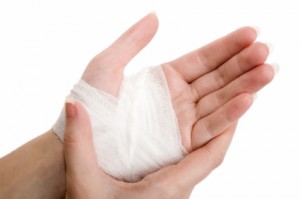A hand injury occurs as a result of damage that affects the structures of the hand caused due to physical trauma.
Important disclaimer: To effectively learn to recognize and manage various hand injuries enrol in workplace approved first aid training.
Classification
The following are the main types of hand injuries:
- Hand fracture. A hand fracture refers to the breakage of at least one bone in the hand
- Hand sprain. The injury affects the ligaments that regulate movement and provide support to the hand
- Hand contusions
- Finger dislocation. This is a major injury in which a finger joint may be displaced or moved out of its original position
- Finger sprain
- Fingernail injury. This can be bleeding under the nail or breakage of the nail that may cause bleeding
- Fingertip amputation
- Tendon rupture
Skin injuries of the hand include:
- Blisters – caused by heat or friction
- Bruises on the hand
- Puncture wounds
- Animal bites
- Lacerations
- Burns
In most cases, some of these injuries are accompanied with others mentioned on the list. For example, a severe hand sprain may occur along with a mild hand fracture. Usually abrasions and cuts occur with fractures and sprains depending on the cause of the injury.
Causes of hand injury
Some common causes of hand injuries are:
- Fist fights
- Altercations
- Kitchen accidents – especially while using the knife
- Sports injuries
- Car accidents
- Crush injuries
- Occupational injuries
- Injection injuries
- Gun shots
Signs and symptoms
Signs and symptoms of hand injuries include:
- Mild to severe hand pain – depending on the type of injury
- Pain may worsen with movement
- Swelling of the hand
- Tenderness of the hand
- Bruises
Major symptoms of hand injuries that require medical treatment include:
- Severe hand/finger pain — pain may worsen with movement or restrict movement
- Worsening of hand swelling
- Worsening of bruises
- Severe bleeding
- Amputation of the hand or finger
- Deformed finger/hand or fingernail
- Inability to move fingers or hand properly
- Significant tenderness o the affected hand bones
- Bone protruding out of any region of the hand
When to seek medical attention
Seek immediate medical attention of any of the following symptoms result from the hand injury:
- A deep puncture wound on the hand
- A severe laceration on the hand
- Worsening bruising of the and
- Injection or pressure injury
- Swelling is worsening
- Hand seems to be deformed
- Finger seems to be deformed
- Bone is protruding out of the skin
- Pain, swelling or deformity is restricting or not allowing movement of the hand or fingers
- Worsening and persistent hand pain for 3 days after injury
- Worsening redness of the affected region of the hand
- Infection: drainage, pus, red streaks, itching
If your doctor has placed your hand in a splint or cast, see him if any of the problems occur:
- Numbness of the hand
- Pain begins to worsen under the splint or cast
- Loss of circulation and sensation of the hand under the cast – skin becomes pale or the finger tips turn blue
- Finger pain worsens
- Infection
Treatment
For finger and hand injuries, follow the treatment steps given below if you only suffer from mild symptoms mentioned above:
1. Cuts and lactations
- Apply direct pressure using a sterile gauze or clean cloth until you stop bleeding
- If blood soaks through, replace the cloth with another clean one or place a clean cloth over the first
- Clean the wound with soap and warm water
- Apply ice on the wound and keep the hand elevated in order to reduce swelling
- In case of an amputation of the finger, place the parts of the hand/finger on TOP of some ice in a clean bag and promptly take it to the nearest hospital
- In case of a deep cut, a puncture wound or an animal/human bite see your doctor immediately in case you cannot administer first aid by removing any foreign bodies or cleaning the wound, to prevent infection
2. Fractures and dislocations
- Apply ice on the affected region to reduce pain and swelling
- Take over-the-counter pain medication such as acetaminophen or ibuprofen
- Do not try to align any displaced bones
- See your doctor as soon as possible
Learn More
To learn more about hand injuries and other wound and skeletal emergencies sign up for a first aid course (more information) with a credible workplace approved provider near you.
Related Video (performed by a doctor – do no try at home)
